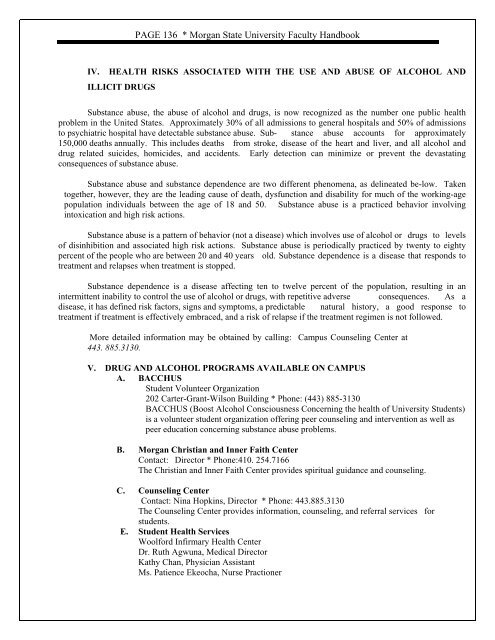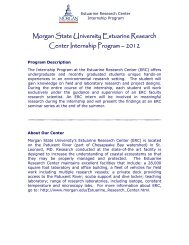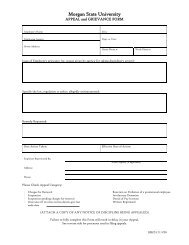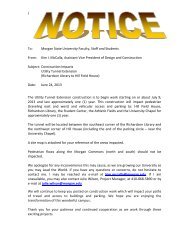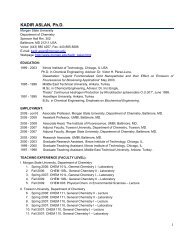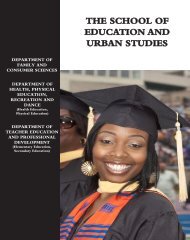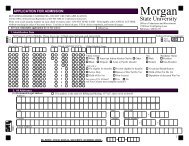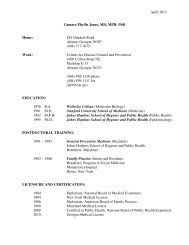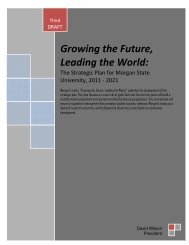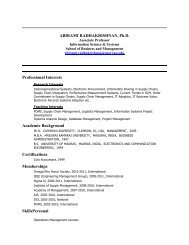FACULTY HANDBOOK July 2009 - Morgan State University
FACULTY HANDBOOK July 2009 - Morgan State University
FACULTY HANDBOOK July 2009 - Morgan State University
Create successful ePaper yourself
Turn your PDF publications into a flip-book with our unique Google optimized e-Paper software.
PAGE 136 * <strong>Morgan</strong> <strong>State</strong> <strong>University</strong> Faculty HandbookIV. HEALTH RISKS ASSOCIATED WITH THE USE AND ABUSE OF ALCOHOL ANDILLICIT DRUGSSubstance abuse, the abuse of alcohol and drugs, is now recognized as the number one public healthproblem in the United <strong>State</strong>s. Approximately 30% of all admissions to general hospitals and 50% of admissionsto psychiatric hospital have detectable substance abuse. Sub- stance abuse accounts for approximately150,000 deaths annually. This includes deaths from stroke, disease of the heart and liver, and all alcohol anddrug related suicides, homicides, and accidents. Early detection can minimize or prevent the devastatingconsequences of substance abuse.Substance abuse and substance dependence are two different phenomena, as delineated be-low. Takentogether, however, they are the leading cause of death, dysfunction and disability for much of the working-agepopulation individuals between the age of 18 and 50. Substance abuse is a practiced behavior involvingintoxication and high risk actions.Substance abuse is a pattern of behavior (not a disease) which involves use of alcohol or drugs to levelsof disinhibition and associated high risk actions. Substance abuse is periodically practiced by twenty to eightypercent of the people who are between 20 and 40 years old. Substance dependence is a disease that responds totreatment and relapses when treatment is stopped.Substance dependence is a disease affecting ten to twelve percent of the population, resulting in anintermittent inability to control the use of alcohol or drugs, with repetitive adverse consequences. As adisease, it has defined risk factors, signs and symptoms, a predictable natural history, a good response totreatment if treatment is effectively embraced, and a risk of relapse if the treatment regimen is not followed.More detailed information may be obtained by calling: Campus Counseling Center at443. 885.3130.V. DRUG AND ALCOHOL PROGRAMS AVAILABLE ON CAMPUSA. BACCHUSStudent Volunteer Organization202 Carter-Grant-Wilson Building * Phone: (443) 885-3130BACCHUS (Boost Alcohol Consciousness Concerning the health of <strong>University</strong> Students)is a volunteer student organization offering peer counseling and intervention as well aspeer education concerning substance abuse problems.B. <strong>Morgan</strong> Christian and Inner Faith CenterContact: Director * Phone:410. 254.7166The Christian and Inner Faith Center provides spiritual guidance and counseling.C. Counseling CenterContact: Nina Hopkins, Director * Phone: 443.885.3130The Counseling Center provides information, counseling, and referral services forstudents.E. Student Health ServicesWoolford Infirmary Health CenterDr. Ruth Agwuna, Medical DirectorKathy Chan, Physician AssistantMs. Patience Ekeocha, Nurse Practioner


